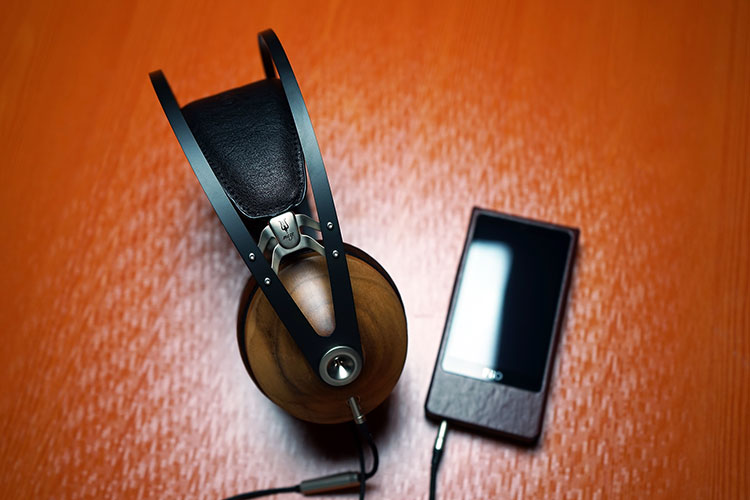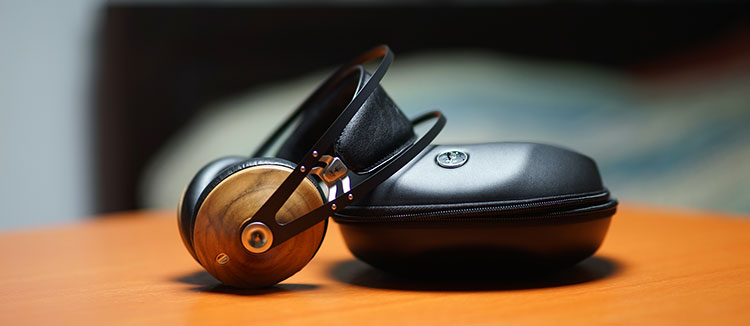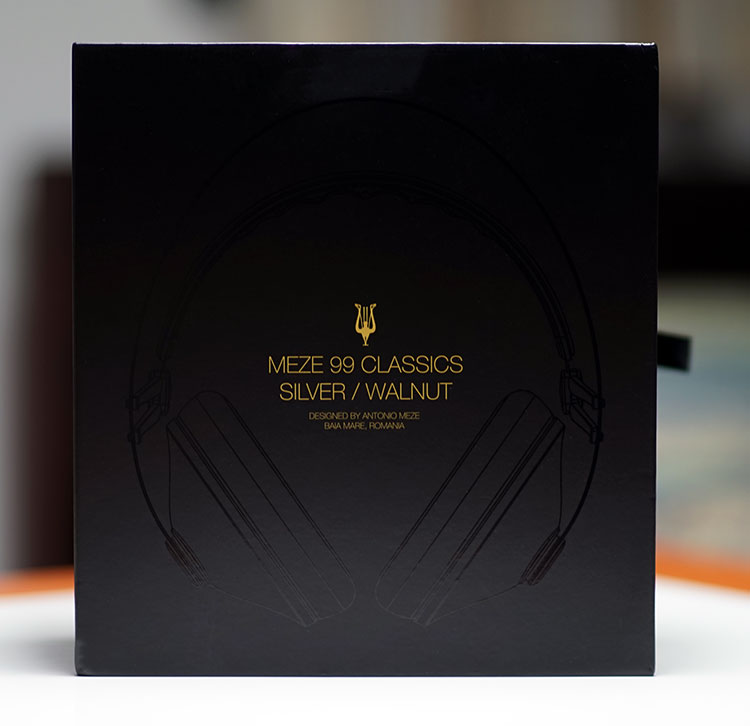99 Classics Sound Impressions
Summary
Despite its woody exterior, the 99 Classics has a very natural-sounding tonality avoiding anything overtly warm and colored which is a welcome relief.
I wouldn’t term it as a wholly neutral sound, there are some colorations in the warmish bass and forward vocal presence which gives it a very addictive musical presentation and pushes all the right buttons for relaxed and pleasurable listening.
The Meze 99 Classic’s pace is smooth, slightly languid, and with reasonable levels of bass decay and a slight mid-bass emphasis. Notes are on the thicker side, particularly on the low end but never overly rounded with the 99 Classics to the point where I felt anything was veiled or muddy.
The soundstage and extension for the 99 Classics are not bad actually for a smallish closed headphone with a bit more height than depth. That forward vocal presence does bring it a bit closer in with a slightly more intimate soundstage than say the wider and more holographic DT1770 or the Philip A5-Pro.
However, the 99 Classics does a great job of keeping instrumental separation clear and conveys a fairly accurate image. If I am pairing this with any genre I am rooting for pop, R&B, and rock. It has that sassy musical vibe that goes so well with the music of this ilk.
Bass
The 99 Classics bass response is elevated, and full sounding with a hint of warmth and a longish decay that gives it a slightly loose feel but there was no real moment that I really felt it overly soft or ill-defined.
It is not omnipresent throughout, and doesn’t hit you with a huge amount of slam; it is more tactile and responsive than that. The mid-bass elevation comes in around 60-80hz so it avoids bleeding into the mid-range. I suspect though if the elevation was tuned any higher say 100 Hz above it would have muddied the lower mids a lot more.
Sub-bass presence is a little more on the polite side though I wouldn’t describe it as rolled off. This is a bass signature more at home with steady BPM modern pop, EDM, and heavy rock.
I would hesitate to put this on with traditional trance. Its tuning is not quite as snappy as the Philips A5 Pro which I consider supreme for higher BPM rhythms. You need a tighter bass than what the 99 Classics has to offer for monitoring of that type.
Mids
The mids on the 99 Classics are very enjoyable and lean more towards a neutral presentation than the warmer bass response. They are nippier, cleaner with very good instrumental separation, and a natural-sounding timbre.
I love these mids with hard rock bands like Disturbed or Corrosion of Conformity; dynamic, clear, and with plenty of ‘crunch’ in their guitar work. Detail retrieval is very good indeed. Vocal presence is a touch forward over the rest of the midrange but not overly so, just enough to bring a healthy bit of focus over the 99 Classics mid-bass elevation.
Vocals, in general, sound very natural with just the right amount of body and very good control over sibilance.
Treble
I did get the impression that Meze dipped the lower treble slightly in favor of a slightly more forward upper treble. Usually, this is my preferred type of treble as it retains sparkle but avoids sounding peaky.
You do lose a little bit of snap and bite in some percussion passages but you also avoid any nasty peakiness and undesirable splashiness that really grates with me.
The 99 Classics peaks closer to 10k than 5-7k so it never feels tapered or lacking in headroom. Overall the treble performance sounds clear and detailed but not so forward or amplified that it fatigues or distracts.
Synergy
Power
The Meze 99 Classics is really easy to drive be it a reasonable smartphone, DAP, or efficient portable amp, the choice is yours.
This is also one of those few headphones that I can have no complaints about with regard to smartphone amping performance. Both my BB Passport and Sony Z Ultra doing more than respectable jobs driving the 99 Classics.
On dedicated DAPs, it really comes down to what flavor of DAP you prefer with all review DAPs easily driving the 99 Classics (FiiO X7, Shanling M5, Sony ZX2).
Portable amping is really not necessary, it is again down to your preferred level of coloration. Honestly, I have some IEMs that require more power than the Meze 99 Classics.
Tonality Matching
For me, I felt the Meze 99 Classics performed at its best with clean and snappy sources or those with excellent dynamics and staging capability.
DAPs like the FiiO X7 with either the AM2 or AM5 modules sounded vivid and exciting with musicality to burn. The Shanling M5 brought a bit more focus on vocals whilst the Sony Zx2 chose to emphasize the bass over all else.
My own personal preference was the M5, something about how it locked onto the 99 Classics’ excellent vocals for rock made the difference. Others will prefer slightly more aggressive profiles like the X7 which for me is the best compromise between musicality and accuracy on the Meze woodies.
Can’t say I was fussed about the bass-heavy Sony experience, if anything, avoid sources and amps with an already dominant low end which tips the 99 Classics away from musicality into bass-heavy bloat.
Select Comparisons
Fostex T50RP Talos Mod
Power
The Meze 99 Classics is ridiculously easy to drive compared to Cascadia Audio’s $250 Talos edition of the T50RP. It is a full 40 steps higher on the X7 with the AM5 module which is really planar volume territory.
This is a headphone that will not play well on modest amping setups compared to the more portable and easy-to-drive 99 Classics.
Physically the Talos is also 10g heavier on the head than the 99 Classics but the pads on the Talos are thicker, focus A type pads used by Hifiman, and are larger circumaural designs than the tighter fitting and shallower 99 Classics.
This makes the Talos the more comfortable fit of the two and shines a light on one area I think Meze could work on for future revisions.
Tonality
Tonally, the Talos has gone for a more neutral sound over the 99 Classics with a nice little hint of elevation in the low end and a forward but hardly intrusive treble.
The 99 Classic’s bass performance is far warmer and heavier hitting but also a little looser than the speedy and articulate planar bass. Even these old planar drivers can still hold their own for bass performance against modern-day dynamics.
Mind you if you want some bass oomph over solid accuracy then the 99 Classics will give you that. Further down the Talos works a little harder in ‘eking’ out a decent sub-bass presence compared to the 99 Classics.
To be fair to the Talos I actually really enjoyed their slight mid-bass elevation but it is not as dramatic as the 99 Classic; perhaps that’s a good thing for those craving for greater accuracy. Both have more neutral and balanced midranges but whilst voicing on the Talos is impressive it’s not as
Both have more neutral and balanced midranges but whilst voicing on the Talos is impressive it’s not as forward, as big, or as euphoric sounding as the Meze vocal presence which is a little bit richer and more center-focused.
Treble on the Talos is a little more forward than the 99 Classics but manages to avoid the old uneven T50RP performance and keeps things impressively smooth.
The 99 Classics treble, though smooth and coherent, doesn’t quite have the same snap as the Talos. Both headphones have an intimate soundstage with decent height and accurate imaging.
Hifiman Edition S
Not as challenging to drive as the Talos T50RP but still requires more juice than the 99 Classics with a full 10 steps higher than the 99 which frankly is in IEM territory judging by these volume settings (60-65 steps).
The Hifiman Edition S pads are not as comfy as the Talos pads but have a slightly better circumaural fit than the 99 Classics though both are on the small side for circumaural. Both have minimal weight difference with the Edition S weighing in at 248g and the 99 Classics at 260g.
The Edition S has the advantage, at least on paper, of having both an open and closed sound through the removable cup plates. In practice, the closed version of the S is thinner and more neutral-sounding than the richer and more natural-sounding 99 Classics.
The closed S, for me, is not as natural and enticing compared to the more musical and inviting timbre of the 99 Classics. It does though have a slight edge on acoustical compositions where that neutral cleaner attack of the closed S sounds more precise than the slightly softer 99 Classics.
Take those plates off the S though and everything warms up a bit, especially on the low end and notes have a slightly softer attack.
The S moves closer to the 99 Classics at this point with an additional emphasis on musicality though it still doesn’t quite have quite the same mid-bass elevation and weight that is immediately evident when switching to the woodies.
Oppo PM-3
Another portable planar that finally sounds almost as efficient as the 99 Classics with only 4-5 steps separating both on the FiiO X7 using the AM5. There is some weight difference between them both, by around 60g.
In practice, the PM-3 is the comfier of the two on the head due to those softer and deeper pads than the memory foam variants used on the 99 Classics.
The PM-3 though is more supra-aural though with a definite on-ear pressure but man those pads are as comfy as anything I have experienced at this price point. Pressure on the PM-3 is also a bit more evenly balanced than the heavier clamp of the 99 Classics.
Tonally the PM-3 is technically the more accurate of the two and the 99 Classics is the more musical. I was not surprised and almost knew that before getting them out of their respective boxes for comparison runs.
I have a feeling purists might gravitate more to the PM-3 which, although still relatively full-sounding, has the tighter better-behaved, and more linear bass response. Both have
Both have a good vocal presence but again the 99 Classics are slightly more in focus and euphoric sounding than the PM-3 more neutral sound. I do prefer the treble performance of the PM-3 a little more than the 99 Classics.
Both are forgiving, both are smooth but I felt the PM-3 was a little more refined and even sounding than the 99. If you want something a bit more even, balanced, and neutral then the PM-3 is a very good alternative.
If you are after something a bit more vivid, vibrant, and musical then the 99 Classics are the way to go.
Our Verdict
I wasn’t expecting much with the Meze Audio 99 Classics woody, I actually believed it might be another more elaborate OEM. Boy, how wrong was I!
I prefer this to the Momentums, the B&W P7’s and it gives the more established PM-3 a real run for its money. Meze has claimed some sort of technical redemption with these musical woodies and quite rightly they should be proud of the end product because they are a lot of fun.
Nothing is perfect in this world and I suspect Meze are working on the feedback they have to date on making this potentially better in the long run such as the pads which need a slight reshaping, a bit more depth and comfort as well as the cables which suffer a tiny bit from microphonics.
It is however very well-finished, durable, and highly serviceable. The new silver edition looks a lot more in tune with my more subdued taste in color combinations, though gold is a top Asian choice from what I am told.
I hate getting carried away with hype but I will admit I do enjoy the 99 Classics more than my conservative values should really allow me. There I said it now excuse me while I sit in a dark cupboard for a while.
Meze Audio 99 Classics Technical Specifications
- Transducer size: 40mm
- Frequency response: 15Hz – 25KHz
- Sensitivity: 103dB at 1KHz, 1mW
- Impedance: 32Ohm
- Rated input power: 30mW
- Maximum input power: 50mW
- Detachable Kevlar OFC cable
- Plug: 3.5mm gold plated
- Weight: 260 gr (9.2 ounces) without cables
- Ear-cups: walnut wood





